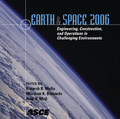Experimental and Computational Studies on Delta Wing Configurations with Different Leading Edge Profiles
Publication: Earth & Space 2006: Engineering, Construction, and Operations in Challenging Environment
Abstract
The flow over delta wing provides a real challenge for experiments and simulations. The leading edge vortex system that forms at high incidence can have significant impact on air vehicles. Couple of features which have caused much controversy over the years have been vortex break down and the formation of substructures in the shear layer rolling up to form the leading edge vortex. A further difficulty is that the vortex breakdown location is highly unsteady, exhibiting oscillations in the streamwise direction. These factors significantly affect the usefulness of the experimental data for aerodynamic analysis and design. Computational simulations are also useful in understanding the role of these factors. The present study deals with experimental and computational investigation of Delta wing with three different leading edge profiles. The experimentations were conducted in a low speed wind tunnel to measure the forces and pressure fields acting on the wing for different angles of attack from –15° to 15° in steps of 5°. The lift and drag coefficients are plotted from the force measurements. The sharp leading edge wing shows an increment in lift at 15° angle of attack. Pressure values obtained are plotted across various spans located at different root chord locations. The change in angle of attack has shown a drastic change in the wing upper surface pressure loading. Computational simulations are made exactly as the experimental conditions using a standard software package and the results are plotted. The experimental values obtained for 21m/s and 38m/s are compared with the computational values, the comparison has show variation in the values. The large radius leading edge wing has shown a better performance than sharp wing at lower angles of attack but at higher angles of attack the sharp wing shows better performance. The results obtained serve as a database for the future delta wing studies.
Get full access to this chapter
View all available purchase options and get full access to this chapter.
Information & Authors
Information
Published In
Copyright
© 2006 American Society of Civil Engineers.
History
Published online: Apr 26, 2012
Authors
Metrics & Citations
Metrics
Citations
Download citation
If you have the appropriate software installed, you can download article citation data to the citation manager of your choice. Simply select your manager software from the list below and click Download.
